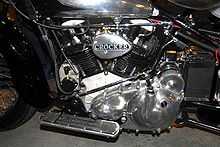Crocker Motorcycles
The Crocker Motorcycle Company was an American manufacturer of single-cylinder speedway racing motorcycles from 1932, powerful V-twin road motorcycles from 1936, and the "Scootabout," one of the first modern styled motor scooters, in the late 1930s. Production ceased in 1942. In 1999 a new corporation was formed to manufacture replica parts, and now produces complete Crockers in kit form, following the original specifications.
Original Crocker company


Over 30 speedway motorcycles were produced before Al Crocker shifted his interest to creating a V-twin road machine that would outperform anything seen on the road. The first V-twin entry for Crocker had a 61 in³ (1,000 cc) "Hemi Head" producing 55-60 hp, far exceeding the horsepower produced by both the Indian and Harley of the day (38-40 hp). Many Crockers were manufactured to order and the largest of them were known to have had a 91+ cubic inch engine (about 1,491 cc), and was the largest-capacity "production" motorcycle until the Yamaha XV1600A took the title in 1998, followed by the Triumph Rocket III, with 2,294 cc (140 in³). When production ceased in 1942, approximately 100 of the V-twins had been produced in all. The remaining inventory of parts were sold in 1947 to Elmo Looper. Many of these parts went into restorations of the surviving examples of which 68 or more still exist today, according to a registry started by Charles "Chuck" Vernon and Johnny Eagles, two members of a group of original Crocker owners in Southern California. Although total production of all models is not known it is thought by some to be around 200 units (about 40–50 speedway, 40–50 "Scootabout" scooters, and 100+ V-Twins). Al Crocker also produced an overhead valve conversion kit in the late 1920s for the Indian 101 "Scout".
The proprietor and founder of the company, Albert Crocker, ceased motorcycle production in 1942 when the war effort put a shortage on critical materials. Indian and Harley received contracts with the US Army for military motorcycle production and Crocker got a contract with Douglas Aircraft making aircraft parts. That became a more lucrative business than Al Crocker ever enjoyed with motorcycle manufacturing and in 1942 Crocker Motorcycle became Crocker Manufacturing. Crocker later sold out to a company named Borg Warner. Al Crocker died in 1961. Designer of many of the components, Paul Bigsby, went on to fame as a designer of guitars and particularly of the Bigsby vibrato tailpiece.
Because of their rarity and quality, Crockers are among the most expensive motorcycles an enthusiast can acquire.[1] At the MidAmerica Auctions motorcycle auction in January 2007 in Las Vegas, a 1941 Crocker big tank motorcycle sold for $230,000. At the Gooding & Co. auction in 2006 in Chandler, a 1931 Crocker 61 sold for $236,500. At the Bonhams & Butterfield 2006 auction in New York, a 1937 Crocker "Hemi-head" V-Twin brought $276,500. At the 2006 auction of Bator International in California a 1939 Crocker 61 cubic-inch side valve model sold for $200,000.
Crocker Motorcycle Company reincarnated
It had been over sixty years since the last Crocker rolled out of 1346 Venice Boulevard in Downtown Los Angeles before the New "Crocker Motorcycle Company" first began to produce parts. After an enthusiastic response to the many high quality parts the new Crocker Motorcycle Company had produced for some of America's top restorers, and with inquires from original Crocker owners, it was decided to officially incorporate Crocker Motorcycle Company in January 1999. In early 2002, CEO Michael Schacht began to trademark Crocker world wide, an aggressive stance was taken to accelerate their parts making process and the quest was on to create all the parts needed to assemble complete and exact reproductions of both the coveted "Big Tank" and "Small Tank" models. The website was launched and their market grew further still. Crocker's customer base is now global.
Crocker Motorcycle Company produces parts that are exactly as the originals by incorporating "old school" pattern making methods with ultra modern measuring and machining technology. Crocker uses CMM (coordinate measuring machine)part measuring for quality control and in many cases CNC machining techniques to ensure the exactness of each part they make. Crocker's casting patterns are made by old world craftsmen who have a dedication to making things correctly, rather than quickly. To ensure a strict quality control, Crocker has created an extensive library of Cad-Cam engineering drawings for every part they produce.[2] All Crocker parts are made in the USA.
Since late 2008, after relocating to Southern California, Crocker Motorcycle Company has been busy refining all their engineering, tooling, metallurgy and manufacturing techniques with the assistance of some of the best Mold makers, engineers and Aerospace machine shops on the planet. The end result is a stunning example of the Crocker Big and Small Tank motorcycles, visually identical to the originals and manufactured to the highest quality standards.
The company began taking orders for its very limited production in October 2011.
References
- ↑ Paul Garson (May/June 2008). "The Crocker Special". Motorcycle Classics. Retrieved 2009-08-07.
- ↑ Margie Siegal (November/December 2007). "The New Crocker Motorcycle Company". Motorcycle Classics. Retrieved 2011-10-04.
External links
- Crocker Motorcycle Company Official Website.
- The Legend That Could Have Been, essay at International Star Riders Association website.
- The Crocker Motorcycle - Jay Leno's Garage